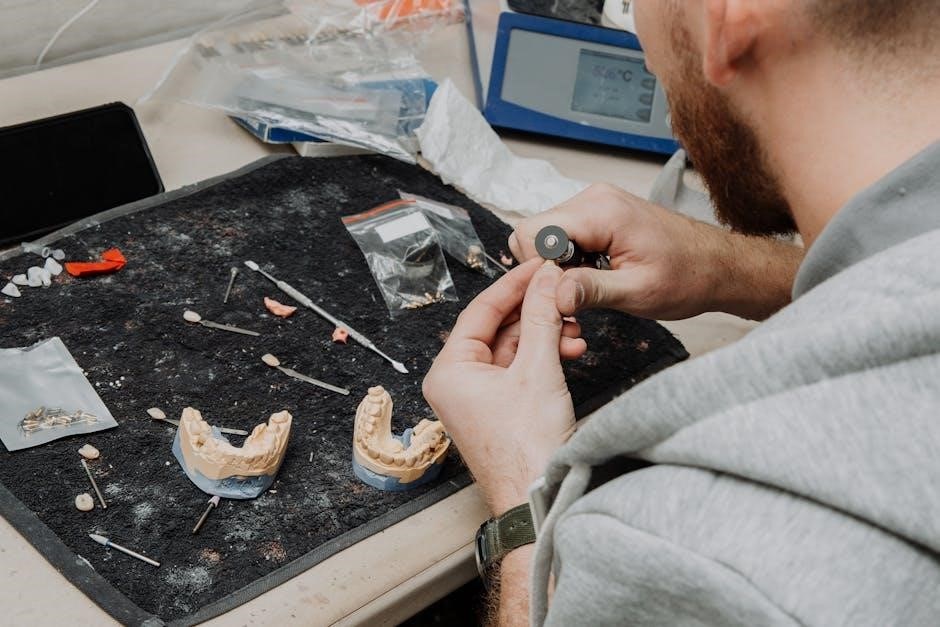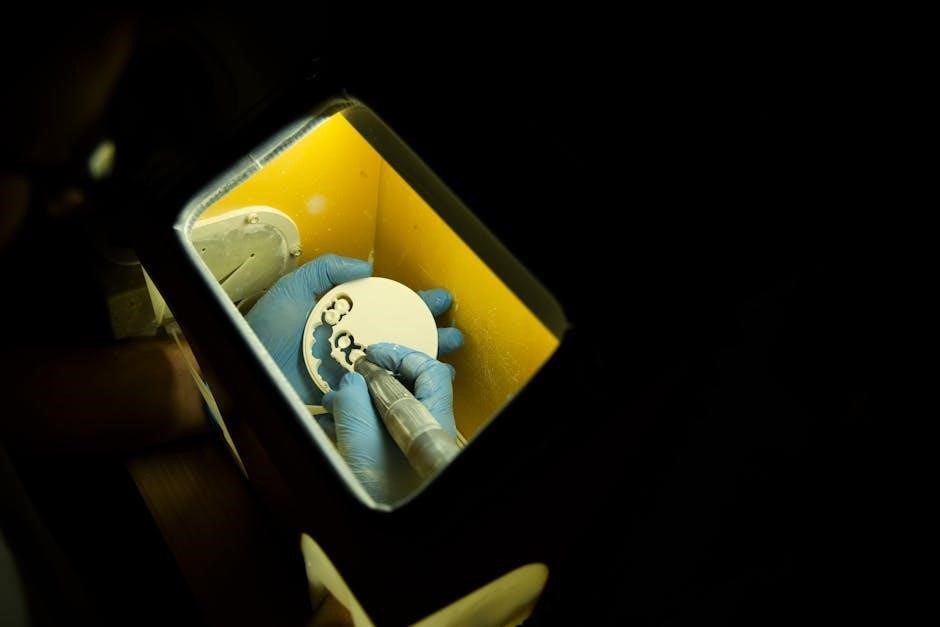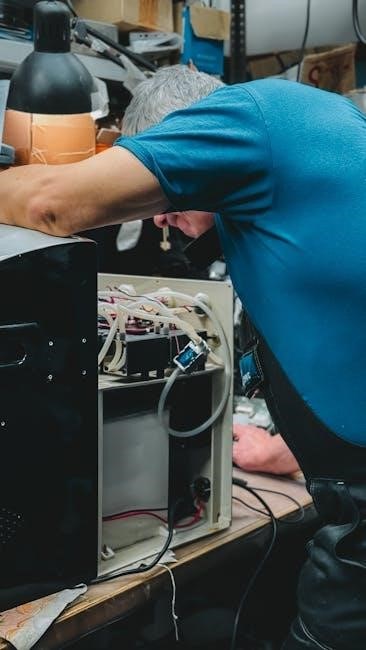The AirCurve ST-A is a bilevel positive airway pressure device designed for non-invasive ventilation, aiding patients with respiratory insufficiency or obstructive sleep apnea. It is intended for patients weighing over 30 pounds, offering tailored pressure settings to enhance comfort and improve breathing during sleep. This device is part of ResMed’s advanced respiratory care solutions, providing effective therapy for various respiratory conditions.
With its intuitive design and clinical versatility, the AirCurve ST-A supports both spontaneous and timed breathing modes, making it suitable for a wide range of patient needs. Its integration with AirView connectivity allows for remote monitoring, ensuring optimal therapy management and patient outcomes. This device represents a significant advancement in sleep therapy technology, combining functionality with patient-centric features.
1.1 Overview of the AirCurve ST-A Device
The AirCurve ST-A is a bilevel positive airway pressure (BiPAP) device designed for non-invasive ventilation. It delivers inspiratory and expiratory pressures to support patients with respiratory insufficiency or obstructive sleep apnea. The device is lightweight, user-friendly, and integrates with AirView for remote monitoring, ensuring tailored therapy and optimal patient outcomes.
1.2 Purpose and Intended Use
The AirCurve ST-A is designed to provide non-invasive ventilation support for patients with respiratory insufficiency or obstructive sleep apnea. It delivers tailored inspiratory and expiratory pressures to enhance breathing comfort and improve sleep quality. Intended for patients weighing over 30 pounds, it is a critical tool in managing respiratory conditions requiring ventilatory assistance.
Key Features of the AirCurve ST-A
The AirCurve ST-A offers advanced bilevel positive airway pressure therapy, tailored pressure settings, and enhanced comfort features. It supports both spontaneous and timed breathing modes, ensuring personalized ventilation for patients with respiratory insufficiency or sleep apnea.
With remote monitoring via AirView and adjustable comfort settings, the device provides seamless integration into patient care, promoting effective therapy and improved sleep quality.
2.1 Operating Modes and Settings
The AirCurve ST-A operates in multiple modes, including spontaneous (S) and spontaneous/timed (S/T) modes. It offers adjustable inspiratory and expiratory pressures, ensuring personalized therapy for patients. Settings can be customized to meet individual needs, with options for pressure ramp, trigger sensitivity, and cycle sensitivity. This versatility enhances comfort and therapy effectiveness.
2.2 Enhanced Comfort Features
The AirCurve ST-A incorporates advanced comfort features like humidification and heated tubing to prevent dryness. It also includes a pressure ramp, gradually adjusting pressure for a comfortable start. Additionally, comfort settings for ramp time and trigger sensitivity can be tailored to individual preferences, enhancing therapy adherence and overall patient comfort during sleep.
2.3 Data Monitoring and Connectivity
The AirCurve ST-A features AirView, enabling remote monitoring of patient data, including usage, leak levels, and respiratory events. Wi-Fi and Bluetooth connectivity allow seamless data transfer to healthcare providers. This ensures timely therapy adjustments and improved patient outcomes, making it a valuable tool for comprehensive respiratory care management and clinical decision-making.

How the AirCurve ST-A Works
The AirCurve ST-A delivers bilevel positive airway pressure, providing higher pressure during inhalation and lower during exhalation. It assists spontaneous breathing and offers timed breaths, ensuring upper airway patency for effective respiratory support.
3.1 Mechanism of Action
The AirCurve ST-A operates by delivering bilevel positive airway pressure, providing higher inspiratory pressure and lower expiratory pressure. This dual-pressure system supports spontaneous breathing while maintaining upper airway patency, effectively addressing respiratory insufficiency and obstructive sleep apnea by ensuring consistent ventilation and comfort during sleep.
3.2 Pressure Delivery and Adjustments
3.3 Integration with Other Respiratory Aids
The AirCurve ST-A seamlessly integrates with other respiratory aids, such as humidifiers and oxygen therapy systems, enhancing therapy comfort and effectiveness. It is compatible with ResMed’s AirView platform, allowing remote monitoring and adjustments. This integration ensures comprehensive respiratory support, tailored to individual patient needs, and facilitates coordinated care for complex respiratory conditions.
The AirCurve ST-A is designed to work seamlessly with other respiratory aids, such as humidifiers and oxygen therapy systems, to enhance patient comfort and therapy effectiveness. Its compatibility with ResMed’s AirView platform allows for remote monitoring and adjustments, ensuring synchronized care and optimized respiratory support for patients with complex needs.

Clinical Applications
The AirCurve ST-A is primarily used for treating obstructive sleep apnea and respiratory insufficiency, offering non-invasive ventilation support tailored to patient needs for improved sleep quality and breathing stability.
4.1 Conditions Treated
The AirCurve ST-A is designed to treat obstructive sleep apnea (OSA) and respiratory insufficiency, providing non-invasive ventilation support. It is also used for patients with chronic respiratory conditions requiring bilevel positive airway pressure therapy. The device is suitable for patients weighing over 30 pounds, offering tailored pressure settings to improve sleep quality and breathing stability.
4.2 Benefits Over Other Ventilation Therapies
The AirCurve ST-A offers advanced bilevel positive airway pressure therapy with spontaneous and timed breathing modes, providing greater comfort and flexibility. Its remote monitoring via AirView enhances therapy adherence and outcomes. The device is lightweight, quiet, and user-friendly, making it more convenient than traditional ventilation therapies. It also supports portability for improved patient lifestyle.
4.3 Patient Eligibility Criteria
Patient eligibility for the AirCurve ST-A includes individuals with respiratory insufficiency or obstructive sleep apnea, weighing over 30 pounds. It is suitable for pediatric and adult patients requiring non-invasive ventilation support. The device is intended for those who can breathe spontaneously and benefit from bilevel positive airway pressure therapy to improve ventilation and sleep quality.
Setting Up the AirCurve ST-A
Setting up the AirCurve ST-A involves connecting the device, configuring settings, and ensuring proper assembly of tubing, mask, and humidifier. Follow the clinical manual for precise guidance.
5.1 Initial Configuration Steps
Begin by plugging in the AirCurve ST-A and connecting the tubing to the device. Attach the mask or nasal interface, ensuring a secure fit. If using a humidifier, connect it according to the manual. Power on the device and navigate through the menu to set basic parameters like pressure levels and mode. Ensure all components are properly assembled before use.
5.2 Customizing Settings for Individual Patients
- Adjust pressure levels based on patient-specific requirements to ensure optimal comfort and therapy effectiveness.
- Set inspiratory and expiratory pressures according to clinical guidelines or patient tolerance.
- Enable comfort features like ramp time or humidification to suit individual preferences.
- Program timers for therapy initiation and duration, if necessary.
- Consult patient feedback and clinical data to fine-tune settings for better adherence and outcomes.
5.3 Ensuring Proper Fit and Comfort
- Ensure the mask fits snugly without leaks, adjusting straps as needed for comfort and a secure seal.
- Assess the mask size and type to match the patient’s facial contours, minimizing discomfort or pressure points.
- Check for proper headgear fit to prevent shifting during sleep and ensure stability.
- Monitor for signs of skin irritation or redness, adjusting the fit accordingly.
- Consider using padded or adjustable headgear for enhanced comfort and patient tolerance.
Monitoring and Adjusting Therapy
Regularly track patient data via AirView to monitor therapy effectiveness. Adjust settings based on clinical assessments and patient feedback to optimize comfort and treatment outcomes.
6.1 Tracking Patient Data
The AirCurve ST-A allows seamless monitoring of patient data through its integrated AirView platform, enabling remote access to therapy metrics. Track usage hours, pressure levels, leak rates, and AHI to assess treatment efficacy. Regular data reviews help identify trends and deviations, facilitating timely adjustments to ensure optimal therapy outcomes and patient comfort.
6.2 Identifying and Addressing Therapy Issues
Monitor for high leak rates, low usage, or discomfort, which may indicate therapy issues. Address mask fit, pressure settings, or humidity levels as needed. Use AirView data to detect trends and intervene early. Regular follow-ups ensure consistent therapy adherence and resolve any emerging challenges promptly, optimizing patient outcomes and device performance effectively.
6.3 Regular Maintenance Checks
Perform routine cleaning of the mask, tubing, and humidifier with mild soap and water. Inspect hoses and connections for wear or leaks, replacing as needed. Check and replace filters every 1-6 months. Monitor humidity levels and adjust to prevent condensation. Test battery backup functionality and schedule annual professional servicing for optimal performance and safety.

Troubleshooting Common Issues
Address alarms and error messages promptly by checking power connections and signal strength. Regularly clean the device and inspect for blockages or wear. Ensure proper assembly of components and verify settings match clinical prescriptions. Refer to the user manual or contact support for unresolved issues.
7.1 Alarms and Error Messages
Address alarms promptly by checking power connections and ensuring the device is dry. Verify signal strength and proper assembly of components. Consult the user manual for specific error code solutions. Common issues include low battery alerts or high leak alerts. Always refer to the clinical manual for detailed troubleshooting guidance and resolution steps.
7.2 Resolving Common Device Malfunctions
Common malfunctions include low battery alerts, sensor issues, or connectivity problems. Ensure the device is clean, and all connections are secure. Restart the device after cleaning. Check for blockages in air filters or tubing. Replace worn-out parts as needed; Always refer to the clinical manual for specific repair instructions and guidelines.
If issues persist, contact ResMed support or a healthcare professional for assistance. Regular maintenance, such as cleaning and updating software, can prevent malfunctions. Keep the device dry and avoid exposing it to extreme temperatures. Proper care extends the device’s lifespan and ensures optimal performance for patient therapy.
7.3 Patient Compliance Challenges
Patient compliance challenges may include discomfort, noise sensitivity, or difficulty adapting to therapy. Address these by ensuring proper mask fit, adjusting pressure settings, and educating patients on device benefits. Encourage gradual acclimatization to therapy and provide emotional support to improve adherence. Regular follow-ups can help identify and resolve compliance issues early.
Additionally, educate patients on the importance of consistent use and proper device maintenance. Offer resources and support to address concerns, fostering a positive experience. Monitoring progress and making adjustments as needed can significantly enhance patient compliance and overall therapy effectiveness for optimal outcomes.
Patient Guidelines and Education
Proper usage techniques, regular cleaning, and mask fit are essential. Educate patients on AirCurve ST-A operation, importance of consistent use, and troubleshooting. Emphasize daily maintenance and remote monitoring via AirView for optimal therapy adherence and outcomes.
8.1 Proper Usage Techniques
Read the clinical manual thoroughly before use. Ensure proper assembly of all components, including mask and tubing. Adjust settings as prescribed by your healthcare provider. Use the humidifier to enhance comfort. Secure the mask firmly to prevent air leaks. Use the device daily as directed for optimal therapy benefits. Turn off the device when not in use and keep the airway clear to ensure proper function.
8.2 Importance of Regular Use
Consistent use of the AirCurve ST-A is essential for effective therapy. Regular use ensures sustained improvement in breathing patterns and sleep quality. Irregular use may lead to incomplete treatment of respiratory conditions, reducing overall therapeutic benefits; Patients should follow prescribed usage schedules to maintain optimal outcomes and consult their healthcare provider for any adjustments.
8.3 Cleaning and Maintaining the Device
- Clean the AirCurve ST-A regularly to prevent bacteria growth and ensure optimal performance.
- Unplug the device before cleaning and avoid using harsh chemicals or abrasive materials.
- Wash the mask, tubing, and water chamber daily with mild soap and water.
- Allow all parts to dry thoroughly before reassembly to prevent moisture buildup.
- Inspect for wear and tear, replacing parts as needed to maintain functionality and hygiene.

Comparison with Other BiPAP Devices
The AirCurve ST-A stands out for its advanced pressure delivery, comfort features, and seamless integration with AirView monitoring. Its unique algorithm and quiet operation set it apart from competitors.
9.1 Market Positioning
ResMed’s AirCurve ST-A is positioned as a premium bilevel device, known for its advanced features and quiet operation. It is widely recognized for its innovative technology and patient-centric design, making it a top choice among healthcare providers and patients. The device’s integration with AirView connectivity further enhances its market standing as a leader in respiratory care solutions.
9;2 Unique Selling Points
The AirCurve ST-A stands out with its advanced bilevel technology, offering adjustable pressure settings for both inhalation and exhalation. Its sleek design, whisper-quiet operation, and integration with AirView for remote monitoring are key differentiators. Additionally, the device supports both spontaneous and timed breathing modes, ensuring versatility for diverse patient needs and enhancing overall therapy effectiveness.
9.3 Patient Satisfaction Ratings
Patient satisfaction with the AirCurve ST-A is consistently high, with users praising its comfort, ease of use, and quiet operation. The device’s portability and integration with AirView for remote monitoring further enhance patient experience. Many report improved sleep quality and breathing comfort, making it a preferred choice among BiPAP devices for respiratory therapy.
Best Practices for Optimal Use
Adhere to clinical protocols, maintain regular cleaning schedules, and ensure proper device setup. Monitor patient compliance and adjust settings as needed for optimal therapy outcomes and comfort.
10.1 Following Clinical Protocols
Adhere to established clinical guidelines for initializing and managing AirCurve ST-A therapy. Conduct thorough patient assessments and titrate settings during sleep studies. Ensure proper device initialization, pressure adjustments, and monitoring. Document patient responses and adjust therapy parameters as needed to maintain efficacy and comfort, aligning with respiratory care best practices and manufacturer recommendations.
10.2 Staying Updated with Manufacturer Guidelines
Regularly review ResMed’s official resources, including user manuals and clinical updates, to ensure adherence to the latest AirCurve ST-A guidelines. Subscribe to ResMed newsletters and participate in training sessions to stay informed about device updates, new features, and clinical recommendations. This ensures optimal use and improves patient outcomes by aligning with current best practices.
10.3 Continuous Patient Support
Continuous patient support is crucial for effective AirCurve ST-A therapy. Provide ongoing education, address concerns, and monitor adherence. Regular follow-ups and access to resources ensure patients maintain proper usage and troubleshoot issues promptly. This support enhances therapy adherence, improving outcomes and patient satisfaction with the device;